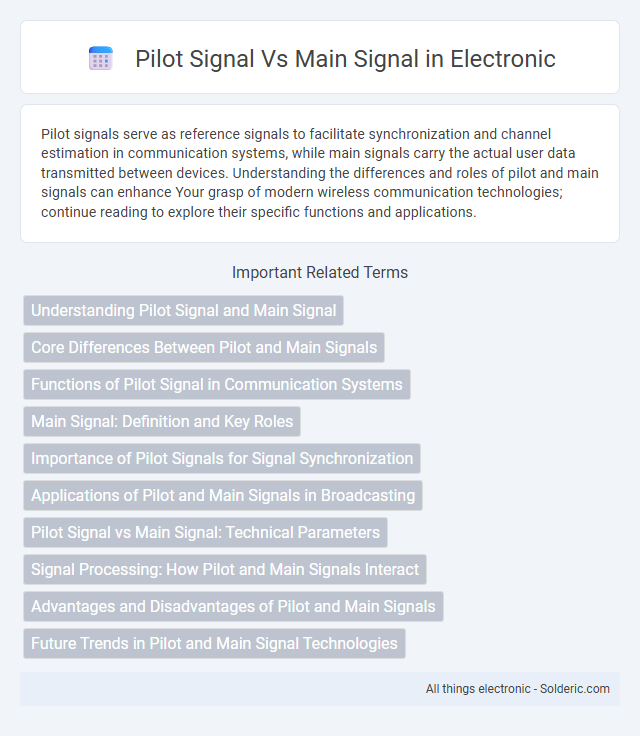Pilot signals serve as reference signals to facilitate synchronization and channel estimation in communication systems, while main signals carry the actual user data transmitted between devices. Understanding the differences and roles of pilot and main signals can enhance Your grasp of modern wireless communication technologies; continue reading to explore their specific functions and applications.
Comparison Table
| Aspect | Pilot Signal | Main Signal |
|---|---|---|
| Purpose | Reference for synchronization and channel estimation | Carries actual user data or information |
| Function | Helps in signal quality and phase adjustment | Transmission of intended communication content |
| Signal Content | Known predefined sequence | Variable user data |
| Usage | Signal processing tasks like error correction and equalization | End-user service delivery |
| Power Level | Usually lower power or pilot power level | Typically higher power for data transmission |
| Examples | LTE pilot tones, DVB pilot carriers | Voice, video, internet data streams |
Understanding Pilot Signal and Main Signal
Pilot signals serve as reference frequencies used in communication systems for synchronization, channel estimation, and signal detection, ensuring accurate data transmission. The main signal carries the primary information or user data intended for communication, relying on the pilot signal for coherent demodulation and error correction. Understanding the interplay between pilot and main signals is crucial for optimizing signal quality and maintaining system reliability in wireless and digital communication networks.
Core Differences Between Pilot and Main Signals
Pilot signals serve as reference signals used for synchronization, channel estimation, and coherent detection in communication systems, ensuring accurate demodulation and decoding of the main signals. Main signals carry the actual user data or information intended for transmission, often modulated and encoded based on the system's specifications. Core differences lie in their functions: pilot signals facilitate system performance and reliability, whereas main signals convey the payload data.
Functions of Pilot Signal in Communication Systems
Pilot signals serve crucial functions in communication systems by enabling channel estimation, synchronization, and coherent demodulation of the main signal. They assist in measuring channel characteristics such as phase and amplitude variations, which improves the accuracy of data recovery and reduces errors. Your receiver relies on pilot signals to maintain signal integrity and optimize overall communication performance.
Main Signal: Definition and Key Roles
The main signal in telecommunications is the primary carrier of information, responsible for transmitting the core data to the receiver with maximum power and clarity. It ensures that your message or data reaches the destination accurately and efficiently, serving as the backbone of communication systems. Compared to the pilot signal, which aids in synchronization and channel estimation, the main signal carries the essential content crucial for end-user applications.
Importance of Pilot Signals for Signal Synchronization
Pilot signals play a crucial role in signal synchronization by providing a stable reference frequency that helps receivers accurately lock onto the main signal's timing and phase. These signals enable precise demodulation and reduce errors in data interpretation, ensuring reliable communication in wireless and broadcast systems. Effective synchronization facilitated by pilot signals enhances overall system performance by maintaining signal integrity even in challenging transmission environments.
Applications of Pilot and Main Signals in Broadcasting
Pilot signals serve as reference frequencies in broadcasting, ensuring accurate synchronization and demodulation of the main signal in systems like FM stereo and digital TV. Main signals carry the core audio or video content, delivering the intended programming to viewers or listeners. The pilot signal's precision enhances signal clarity and stability, making it essential for high-quality broadcast transmission.
Pilot Signal vs Main Signal: Technical Parameters
Pilot signals serve as reference frequencies in communication systems, typically exhibiting lower power and narrower bandwidth compared to the main signals which carry the primary data payload. Technical parameters such as signal-to-noise ratio (SNR), modulation scheme, and frequency allocation differ significantly, with pilot signals designed for stability and synchronization while main signals prioritize bandwidth and data rate efficiency. Your system's performance hinges on the precise calibration between these signals to ensure accurate channel estimation and coherent demodulation.
Signal Processing: How Pilot and Main Signals Interact
Pilot signals serve as reference tones in signal processing, enabling accurate channel estimation and synchronization for the main signal. The main signal carries actual information data, relying on the pilot signal to compensate for distortions, phase shifts, and fading effects during transmission. Together, pilot and main signals enhance communication system robustness by improving error correction and signal demodulation accuracy.
Advantages and Disadvantages of Pilot and Main Signals
Pilot signals enhance communication system stability by providing reliable synchronization and channel estimation, improving overall signal quality. However, they consume additional bandwidth and power, which may reduce the efficiency of data transmission. Main signals carry the primary information but are more susceptible to distortion and require more complex processing to maintain integrity in varying channel conditions.
Future Trends in Pilot and Main Signal Technologies
Emerging trends in pilot and main signal technologies emphasize enhanced synchronization and improved interference mitigation through advanced machine learning algorithms. Integration of pilot signals with 5G and beyond networks enables dynamic channel estimation, boosting spectral efficiency and reducing latency in real-time communication systems. Future signal processing techniques focus on maximizing energy efficiency and reliability by leveraging massive MIMO and intelligent reflecting surfaces to optimize pilot-main signal coordination.
pilot signal vs main signal Infographic

 solderic.com
solderic.com